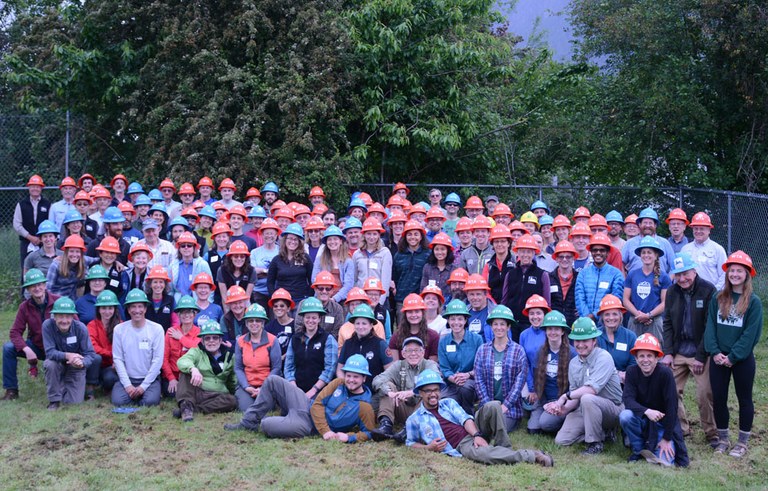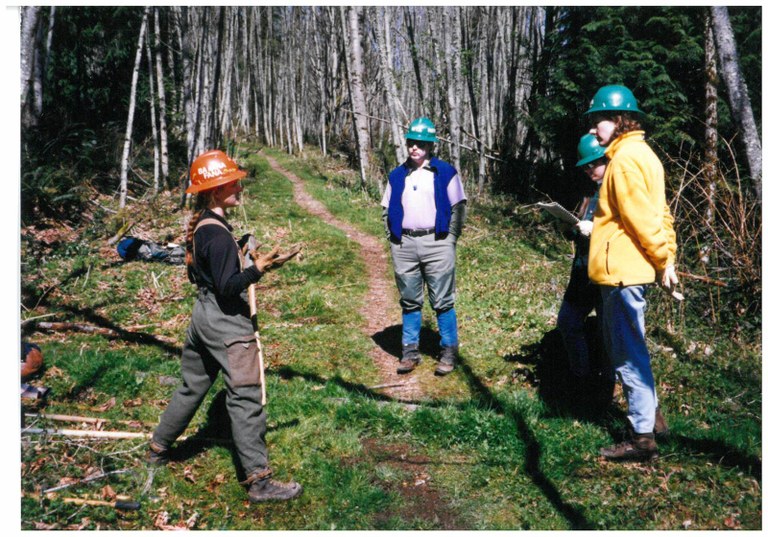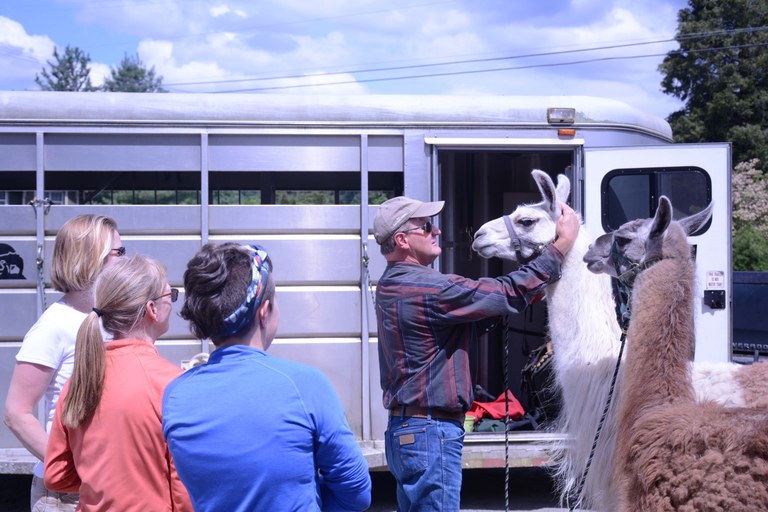Our Graduates Are Out-standing In Their Field
It's the crew leader and assistant crew leaders (many of them volunteers) who have helped WTA's trail maintenance program become what it is today. Learn how we train the people who lead you on trail.
This year WTA celebrates the 25th anniversary of our trail maintenance program. With thousands stepping up to help us keep Washington’s trails in the best condition possible, we’re a force to be reckoned with.
Fortunately, our network of dedicated leaders helps us manage the many volunteers who join us each year. WTA crew leaders and assistant crew leaders welcome anyone who comes out on a work party, keeping the crew safe and making the fun happen, all while getting high-quality trail work done.

The 2018 Crew Leader College class ... out standing in a field. Photo by Anna Roth.
How do we have so many experts in our ranks? They’re supported by an annual training weekend known as Crew Leader College. Each year in May, WTA’s volunteer leaders head to North Bend and spend two days learning technical trail building skills and how to work with volunteers. This year, 150 people attended, one of our largest classes.
But our volunteer leadership base hasn’t always been so big. Our program started in 1993, when one of WTA’s founders Greg Ball convinced the Forest Service to let him and a handful of volunteers do some of the maintenance the agency couldn’t keep up with. That idea took off, and the program flourished in its very first year.
Watching and Learning
One requirement of that original agreement was that our work had to conform to Forest Service maintenance standards. At first, those trainings were on the fly. The Forest Service showed WTA how they wanted work done, and we learned how to do maintenance on-trail, during the work day.
Volunteers developed their skill set according to what the day's project was, and as they did more work parties, they gained enough experience to teach newcomers how to dig a drain dip or build a rock wall. This sharing of expertise still goes on at every work party, as assistant crew leaders guide volunteers through the days project.
But just two years into the trail maintenance program's existence, WTA realized the need to formalize trainings. Our volunteer base was growing by leaps and bounds, and we needed to ensure all our leaders were teaching the same techniques. An informal training session was pulled together, called "Cougar College" because it was held on Cougar Mountain.
“Those first trainings were open to the public, and they weren't quite as structured as the weekend is now,” said Alan Carter Mortimer, WTA's Field Programs Manager, who was at the first Cougar College as a volunteer.

A class at one of WTA's first formal Crew Leader Colleges. Photo from WTA archives.
Shortly after the advent of Cougar College, we decided to make the trainings specifically for WTA's leaders, and shifted it to Hood Canal, thanks to a volunteer who offered to do logistics for the weekend.
But as people began to join us from all corners of the state, we moved what was now known as Crew Leader College to the North Bend ranger station to make it more accessible for people coming from outside the Puget Sound area. Last year we moved to the North Bend Elementary School because the student body had gotten so large!
Gaining Trail Cred
Crew Leader College came into existence as an opportunity for people in WTA’s trail maintenance community to develop their volunteer skills toolkit, and as the program gained experience and grew, the classes offered changed, too.
Originally, the Forest Service gave us annual maintenance projects and relatively basic trail tasks. But as we proved volunteers could do quality work, the agency entrusted us with more complicated projects (and more of them).
In addition to fundamental concepts like clearing drainage and rock structures, we began to learn more complex techniques, like Basic Rigging and Highlines (including ziplines, which help reduce volunteer impact on worksites), structure construction, even Trail Layout and Design, where volunteers learn how to assess a piece of land where a new trail might be built. This means WTA can not only help complete intricate projects; we also have some input in how Washington’s trail system develops.
Our partners at the Forest Service continue to be involved in our trainings. Several of the classes are taught by WTA crew leaders and land managers together. And they've noticed changes over the years. George Winters, a Forest Service employee based out of Darrington has been with us since early years. He had this to say of the 2018 Crew Leader College:
Learning New Tricks
This year, we added several new classes to keep building the skill set of our leaders. One, taught by Logistics Coordinator Rick Beckel and llama packer Charley Rosenberry covered how to pack for our backcountry trips supported by stock.

Learning how to pack with llamas is one of the newest classes at Crew Leader College. Photo by Anna Roth.
The logistics coordinator ensures our volunteer vacations are properly equipped, and with 43 trips going out in just six months, having volunteers who know how to help pack is a must. We rely on support not only from Charley and his llamas, but from many chapters of Back Country Horsemen of Washington to get our work done at those backcountry project sites.
Another a class was on Cultural Artifacts, taught by King County Parks archaeologist Brandy Rinck. Rachel Wendling, a 22-year old assistant crew leader and WTA's communications associate loved the class.
“It was fascinating to learn how common cultural artifacts are around the Puget Sound area. I feel better equipped to identify when something may be considered a cultural artifact, and how to respond if I run across one on trail.”
Finding Common Ground
Our growing group of volunteer leaders has allowed us to diversify where we work, and as we’ve expanded into new communities, we realized a need to develop some soft skills. About five years ago, we added Leadership and Emergency Response to the curriculum.
This helped teach our leaders how to handle backcountry emergencies, but also how to manage larger groups of volunteers. Over the years, our base of volunteers and leaders has become increasingly diverse and reflective of the communities in which we work, something we're happy to see. Andrew Lee has seen the change in the five years he’s been volunteering with WTA.
“As someone who is Asian, I can say there weren’t many people at my first Crew Leader College [four years ago] who looked like me. Now, I see more people in the crowd closer to my age, but also reflecting more races, creeds, and cultures. That makes me excited."

Andrew Lee with longtime volunteer Lucie Johns at Sharpe Park, where we helped build the Tursi Trail in 2016. Photo by Anna Roth.
He continued: "I’m happy we have so many people who are willing to go out, no matter what they look like; they just have a common interest. I think the bonding and the shared love of trails is what’s important. I hope WTA continues to push that forward, and provide a safe space where we just work together on a trail and learn about each other. That’s the most exciting thing about the future of WTA for me.”
Like Andrew, I've also attended four Crew Leader Colleges, and one of the most rewarding things about them is spending time with the many inspiring, fun, and motivating people who are part of WTA's trail maintenance community. It's gratifying to be part of the community; I can't wait to see what we can to together in the coming years.


Comments